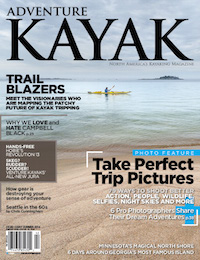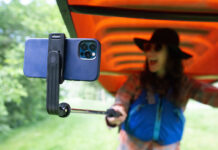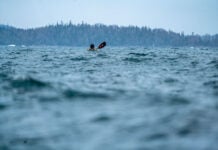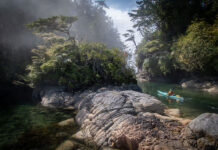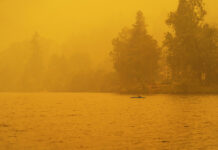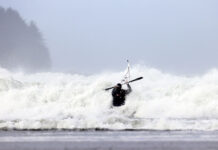Work deadlines, family commitments, romantic distractions, dirty laundry, Zumba class. Our busy lives are already chock full of excuses that keep us from paddling. Gear shouldn’t be one of them.
Lately, however, I’ve noticed a concerning trend: The very equipment that is supposed to help us get outside sometimes holds us back.
In our quest to find the perfect gear to ac- company the perfect trip, we lose spontane- ity and flexibility, stretch our bank accounts and limit our opportunities for actually getting out on the water.
Some recent conversations with paddling friends have gone something like this:
“Hey, I’m going kayaking this weekend— want to come?”
“I’d like to but I don’t have ___ (Insert: ul- tralight tent; ideal expedition boat/surf boat/ whitewater boat; drysuit; carbon fiber paddle; multi-fuel backpacking stove; self-inflating, six-inch-thick, down-filled camping mattress; hybrid ultra-compressible sleeping bag; high- protein, organic, dehydrated meals).”
I’m thankful for developments in outdoor gear, but it also seems that once upon a time, paddling was a less elaborate—and less elit- ist—undertaking.
Maybe it’s a question of social circum- stance, geographic location, changing
demographics or other factors. Maybe I have rose-colored memories of summer camp trips with ridiculously heavy canoes, family trips with old canvas tents and semi-successful boat-building projects on the local pond with my siblings. Sometimes we sported cut-off jeans, often we wore old woolen sweaters. I can’t even remember our footwear or lack thereof.
Let me be clear, I am absolutely in favor of being well prepared with good gear. When guiding a 20-day trip on a remote northern river, you can be sure that I’ve triple- checked every sat phone battery, personally tested each tent zipper and carefully waterproofed and packed all the food (including the emergency meal, the extra emergency meal and the extra extra emergency meal). Even when I’m out for a relaxing afternoon paddle within splashing distance of city limits, I bring a standard safety kit and my holy crap emergency dry bag (see “DIY Ditch Kit,” page 68).
And I recognize that there is much joy to be had in months of planning for a long paddling trip to a dream location. Some- times, that’s just about all that gets me through dreary winter days. But I’m tired of people who don’t want to go paddling unless they’ve been memorizing charts and dehydrating meals for months in ad- vance. We may not all paddle Haida Gwaii, Belize or Patagonia this year, but we can all choose to get out when we can, where we can, with what we have.

WE REMEMBER THE MEALS.
PHOTO: STEVE ROGERS
Some of my most memorable paddling adventures were spontaneous, low-tech excursions. While working a busy sum- mer season on the north shore of Prince Edward Island, I had an unexpected two days off. Within an hour, I was in a kayak heading for the most remote, unpopu- lated piece of coastline
I could find. In those 48 precious hours I paddled 100 kilometers, explored stunning cliffs and beaches, camped just above the high-water line in a tiny cove, survived on nothing but canned peaches and trail mix, and returned back to work utterly happy, tired and inspired.
Sometimes a spontaneous paddling trip can help us find perspective.
Last fall, with the end of the season looming, some friends and I were com- plaining about how we hadn’t gone camp- ing enough lately. The obvious solution: we tossed gear into trunks, loaded boats onto roofs and carpooled north for a last- minute trip to a favorite island. After a golden sunset, we slept peacefully as the waves pounded the rocks below. When
I returned home Sunday evening—after perhaps only 10 kilometers of paddling—I felt ready to take on the world again.
Anthropologists who study these sorts of things would point out that North American society—fueled by the powerful forces of media and advertising—is infatuated with the pursuit of material satisfaction. We seek to define our identity by our possessions.
A study from the University of British Columbia found that spending our resources on new experiences, rather than more pos- sessions, produces longer-lasting feelings of satisfaction. This is a concept that should be familiar to outdoor enthusiasts—wasn’t the spectacular sunrise more memorable than the tent you watched it from?
Spending our resources on new experiences, rather than more possessions, produces longer-lasting feelings of satisfaction.
New gear does not lead to the perfect trip. Some of my equipment is decades old but it still works safely and reliably. No self-respecting gearhead would give my faded tent a second glance, but it’s bombproof, has spent hundreds of days in the field and invariably keeps me dry and warm. Yes, there are lighter tarps, more powerful stoves and loftier sleeping bags. And yes, there are boats with higher or lower volume, more speed, less weight, better hatches and sexier colors. I’d happily give a home to one or five of them.
There is nothing wrong with good gear. But I worry that by focusing on acquiring the newest, best, lightest, most high-tech gear, we are making outdoor experiences more elusive. Not everyone can afford to shell out hundreds of dollars for a Gore- Tex drysuit or silnylon tent. And most
of us won’t have an incredibly improved experience with a boat that weighs five pounds less or a stove that cooks water half a minute faster.
In some countries, simple, economical outdoor experiences and learning are con- sidered such an integral part of existence that a word—Norwegians call it friluft- sliv—has even been coined to describe this way of life. While the image of North America has its roots in wilderness experi- ence, in reality many people rarely have or take the opportunity to seek out experi- ences in the natural world.
If outdoor adventure sports are per- ceived as elitist, expensive and inacces- sible, even fewer people will get involved and learn to value these experiences. Enter the modern pitfalls of our soci-
ety: sedentary lifestyles, indifference to environmental issues, lack of connection to other people and lack of connection to the inspiring, challenging and beautiful forces of the natural world.
This is where we paddlers can come in as fearless visionaries of a world where getting outside is a way of life—not a privi- lege, quirky hobby or inaccessible dream.
So go ahead, get that carbon fiber paddle you’ve been dreaming about. But don’t throw away your old plastic blade. Give it to your new neighbor who’s never been in a kayak before (and lend him or her your other spare gear), call some friends and go paddling. No excuses.
Charlotte Jacklein paddles with an eclectic mix of new and old gear, whenever and wherever the water beckons.
